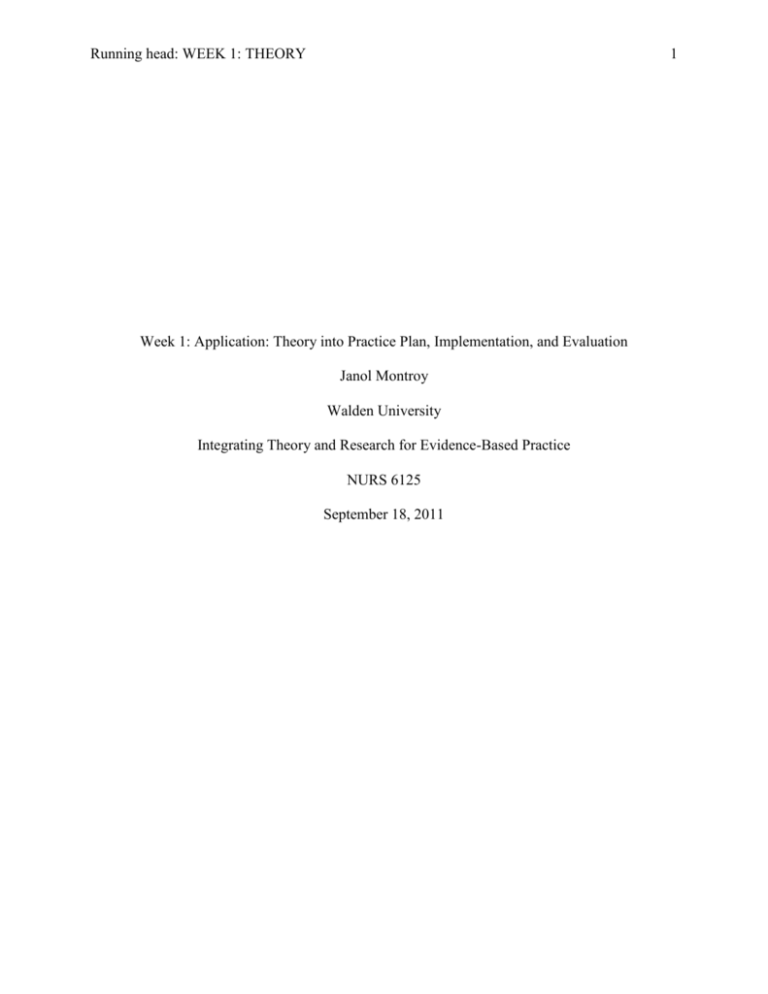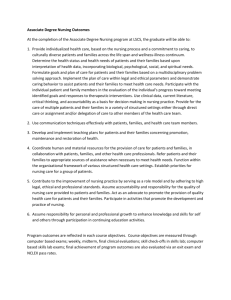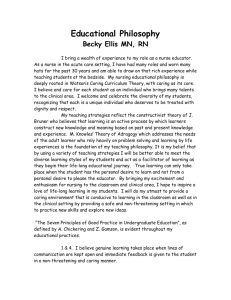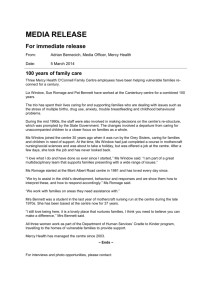Theory into Practice Plan, Implementation, and Evaluation
advertisement

Running head: WEEK 1: THEORY 1 Week 1: Application: Theory into Practice Plan, Implementation, and Evaluation Janol Montroy Walden University Integrating Theory and Research for Evidence-Based Practice NURS 6125 September 18, 2011 WEEK 1: THEORY 2 Week 1: Application: Theory into Practice Plan, Implementation, and Evaluation APA does not require a heading for the introduction Nursing is a caring profession. The desire to help others, lifelong learning and growth is a universal desire of the nursing profession. "Nursing theories and models continue to be a positive influence on nursing practice." (Lukose, 2011, p. 27). Health care and our world today reveal constant change. Dr. Jean Watson's theory of human caring developed in 1979, continues to be relevant, and needed in the nursing profession and health care today. Purpose and Rationale This question refers to the purpose of the theory and your rationale for choosing it The purpose and rationale for the theory of human caring embodies a philosophy and a nursing theory. (Parker & Smith, 2010, p. 359). "Caring science orientation is necessary for the survival of nursing as well as humanity at this crossroads in human evolution." (Parker & Smith, 2010, p. 353). There are 10 carative factors that are relevant to "clinical carative processes." (Parker & Smith, 2010, p. 354). Rational for this theory and nursing practice is the concept of "ongoing personal-professional development" that impacts both patient and nurse. (Parker & Smith, 2010, p. 357). The theory of human caring is utilized in the healthcare setting which includes nursing administrators, nursing educators, advanced practice nurses, bedside nurses and health care organizations to name a few. Dr. Watson states "nurses are torn between the human caring values and the 'calling' that attracted them to the profession, and the technologically, high paced, task-oriented biomedical practices and institutional demands, heavy patient load, and outdated industrial practices." (Watson, 2009, p. 467). Where is the description of the theory? Critical Appraisal WEEK 1: THEORY 3 The theory of human caring can be 'read' as a grand theory as well "as middle range theory when read at the "carative factors/caritas process, which provides the structure and language of the theory as both middle range and specific." (Parker & Smith, 2010, p. 355). When used in the clinical setting there are "specific language systems" that are used as well as research projects, assessment tools within hospital and nursing practice. (Parker & Smith, 2010, p. 356). Watson's theory of human caring is used as a model in some hospitals "seeking or sustaining magnet status." (Watson, 2006, p. 89). The simplicity Simplicity refers to the number of concepts. The greater the number of concepts, the more complex the theory.of human caring seems evident "because it uses theories from other disciplines" that "are familiar to nurses." (McCance, McKenna & Boore, 1999, p. 1393). The theory of human caring and the 10 carative factors show accessibility with relevance and importance to nursing practice. The philosophy of human caring is important to our society and challenging to comprehend because of continuing evolving concepts. Whose appraisal criteria did you use? Plan The desire to meet the expectations of the patient and families in the labor and delivery setting is a goal of the labor and delivery nurse, management and our health care organization. Staff meetings and communication in the hospital where I work, reflect continual encouragement to show genuine caring and concern for our patients. Patient satisfaction surveys reflect a lower score regarding listening to our patients in labor and delivery. Dr. Jean Watson's theory of human caring and the 10 carative factors would be very beneficial to this labor and delivery unit as well as mother baby. "Watson describes the basis or core of nursing as "those aspects of nursing that actually potentiate therapeutic healing processes and relationships; they affect the one caring and the-one-being-cared-for." (Sitzman, 2002, p. 119). The plan for implementing WEEK 1: THEORY 4 this theory would start with education regarding the theory of human caring by Dr. Watson in the form of a workshop presentation for staff. A questionnaire and survey would be implemented before the workshop to identify needs and knowledge of the staff regarding nurse-patient caring as well as self-care. A yearlong project related to caring would be reinforced by poster, communication and handouts on a monthly basis. Great idea The listening scores and patient satisfaction results would continue to be closely monitored and communicated to staff each month. Staff involvement in this project would be offered and encouraged. Challenges to this plan would be in arranging for everyone to attend this workshop. The mother baby unit would also need to be involved, which adds increased number of staff attending the workshop. Addressing a caring theory and philosophy could be considered by some of the staff as unnecessary. Many of the hospitals in the organization have magnate status. This would also be an advantage for our unit to exemplify this genuine need for concern and caring for nurses both professionally and on a personal level. Good plan, You are including your staff in the process from the beginning. You are educating them about the theory , you are reinforcing caring concepts . and you have an evaluation plan. Conclusion Nursing practice is centered around a caring attitude and interpersonal relationships. "The art of nursing has been defined as "the finest of the fine arts, incorporating the soul, the mind, and imagination of the practicing nurse." (Caruso, Cisar & Pipe, 2008, p. 126). The theory of human caring by Dr. Jean Watson is timeless in the profession of nursing and society. WEEK 1: THEORY 5 References Caruso, E. M., Cisar, N., & Pipe, T. (2008, April-June). Creating a healing environment. An innovative educational approach for adopting Jean Watson’s theory of human caring. Nursing Administration Quarterly, 32(2), 126-132. Retrieved from http://journals.lww.com/naqjournal/pages/default.aspx Lukose, A. (2011). Developing a practice model for Watson’s theory of caring. Nursing Science Quarterly, 24(1), 27-30. doi: 10.1177/0894318410389073 McCance, T. V., McKenna, H. P., & Boore, J. (1999). Caring: theoretical perspectives of relevance to nursing. Journal of Advanced Nursing, 30(6), 1388-1395. Retrieved from http://www.blackwellpublishing.com/journal.asp?ref=0309-2402&site=1 Parker, M. E., & Smith, M. C. (Eds.). (2010). Nursing theories & nursing practice (3rd ed.). Philadelphia: F.A. Davis Company. Records, K., & Wilson, B. (2011). Reflections on meeting women’s childbirth expectations. Journal of Obstetric, Gynecologic & Neonatal Nursing, 40, 394-398. doi: 10.1111/j.1552-6909.2011.01269.x Sitzman, K. L. (2002, May/June). Interbeing and mindfulness. A bridge to understanding Jean Watson’s theory of human caring. Nursing Education Perspectives, 23(3), 118-123. Retrieved from http://www.nln.org/nlnjournal/index.htm Swift, C., & Drach, S. (2010). Satisfaction for all: Your patients, your nursing staff, & your organization. Journal of Obstetric, Gynecologic & Neonatal Nursing, 39, S48-S84. doi: 10.1111/j.1552-6909.2010.01121.x WEEK 1: THEORY Watson, J. (2006, July-September). Caring theory as an ethical guide to administrative and clinical practices. JONA’S Healthcare Law, Ethics, and Regulation, 8(3), 87-93. Retrieved from http://journals.lww.comm/jonalaw/pages/default.aspx Watson, J. (2009, Spring). Caring science and human caring theory: Transforming personal and professional practices of nursing and health care. Journal of Health & Human Services Administration, 466-482. Retrieved from http://www.spaef.com/jhhsa.php 6





